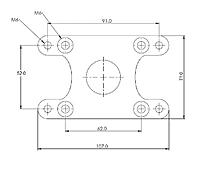102" Purpose-Built-Electric SU-26 with sheeted foam wings, stabs, and turtledeck, with high density foam and 1/16th inch balsa. It's covered in genuine Oracover and the ailerons can be cut to custom sizes for IMAC, 3D, or XA. 6800W of power and enough capacity for 5.5 to 6 minutes bring the plane to an AUW of 24.34 lbs RTF.
Covered weights:
Fuse + Rudder = 2165g
Battery Tray = 83g
Firewall = 101g
Motor Beam Top & Bottom = 103g
Wing 1 = 941g
Wing 2 = 944g
Wing Decals = 99g
Stab 1 = 236g
Stab 2 = 236g
Cowl = 528g
Canopy = 267g
Wing Tube = 169g
Stab Tube = 66g
CF Landing Gear = 197g
CF Tailwheel Assembly = 57g
KavanLite 5" Wheels = 147g (stock wheels are heavier)
Steel 6mm Axles & Hardware = 32g
Hardware = 39g
Triangle Stock and Doublers = 28g
Total Empty Weight = 6438g or 14.19 lbs
We now have a new StinGR gear reduction unit on the plane too with a 28x13 Falcon C2E with a 12S 8000mAh main pack. The power unit pulls 58 lbs of thrust.
StinGR 5035 Power System = 1548g
Tribunus II 200A ESC = 235g
2x 6S 8000mAh main pack = 2215g
Falcon 28x13 C2E = 125g
Falcon 5" Carbon Spinner = 108g
AR8010T = 24g
Ultra Guard BEC Backup = 41g
5x Servos with arms and extensions = 525g
Total Power & Control components = 4.821 kg or 10.63 lbs
Total AUW = 24.85 lbs
This is an 8.32 oz/cu ft cube loading and a 29.8 oz/sq ft wing loading.
MAC * Wingspan = 1921 sq in wing area
CG at 25% Static Margin = Center of the
...Continue Reading














